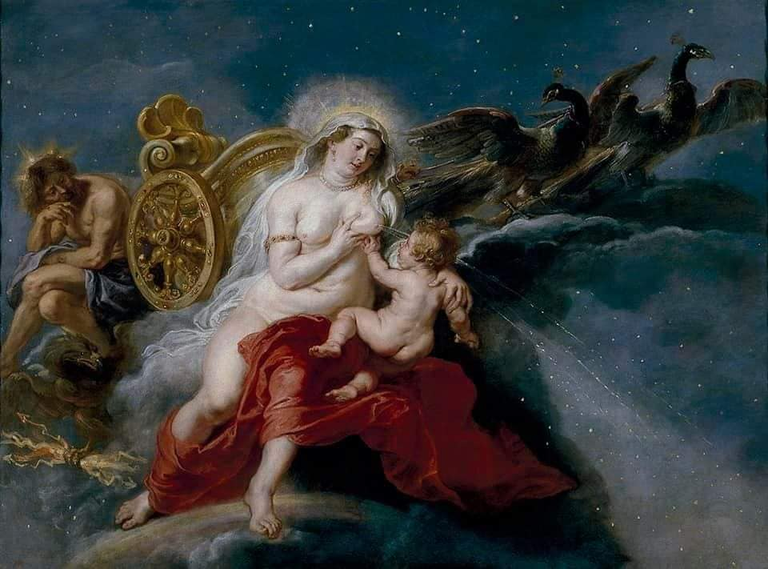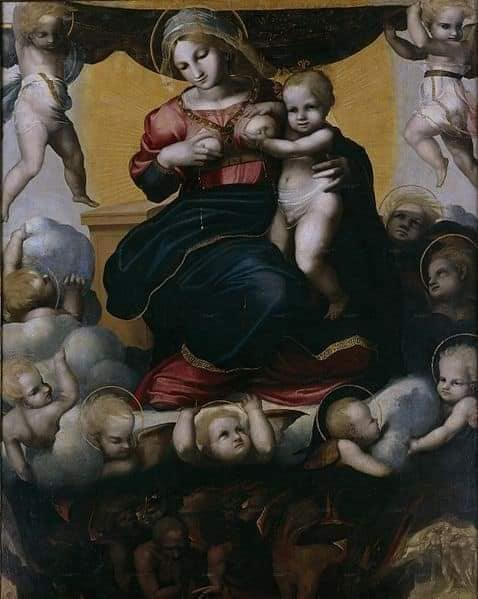Dr. Rebecca M. Bender
Associate Professor of Spanish Language and Literature
Breastfeeding Religious, Mythological and Pagan Roots
… a few observations I made about the frequent and elaborate depictions of breastfeeding in the artworks that adorn the walls of the Prado's gallery
El Bosco - “Jarden de las Delicias” [Garden of Earthly Delights] (Netherlands, 1490-1500).
Aside from these “academic” observations of Spanish culture and art history, which stemmed largely from my undergraduate studies and research, I saw an overabundance of artwork depicting breastfeeding. After two particular paintings caught my attention because of their detailed inclusion of breastfeeding, I began to jot down all the pieces that included this theme. I ended up with a list of 12 works - 11 paintings and one sculpture. In four days I covered about 80% of the museum - I missed a few sculpture rooms, so there could be more. But for now, I'll include these 12 works with very brief comments and links to the Prado's galleries (unless otherwise stated, all images come from the Museo del Prado's website). I guess I'll consider this post a public service – if you ever visit the famous museum in Madrid, now you can use my blog as your personal guide to “Breastfeeding in the Prado”!
Among these breastfeeding paintings
"San Bernardo y la Virgen" by Alonso Cano (1645-52).
I'll start with the first two paintings that stopped me in my tracks. One is based on a religious (Catholic) story and the other on mythology. The first (above), Spanish painter Alonso Cano's “San Bernardo y la Virgen,” was completed between 1642-52. According to information provided by Javier Portes Pérez of the Prado website, St. Bernard is known for promoting the lifelong celebration and veneration of the Virgin Mary (Virgin Cult). She shares her milk as a reward for his devotion. This is a popular story in Baroque Spain that linked Catholic Marian devotion to mystical action. Next (below), Flemish painter Peter Paul Rubens's "El Nascimento de la Via Lactia" ("Birth of the Milky Way") was completed in 1637. Along with other paintings by Velázquez, this large piece “Torre de la Parada” is a royal residence of the Spanish Monarchy near Madrid. Many of the scenes depict the stories of the gods and are depicted in classic works such as Ovid's poem "The Metamorphosis." Rubens' aim was to capture the moral essence of these stories as well as the attitudes of the characters. "Birth of the Milky Way" Hercules, the son of Jupiter and Alcmene, was placed by his father on the breast of his sleeping wife Juno, so that her breast milk would make his son immortal. However, Juno wakes up, and when the baby is removed from her breast, the milk leaks out, and then the stars of the Milky Way are formed.
There is another painting
El nacimento de la va lactea (Birth of the Milky Way) by Pedro Pablo [Peter Paul] Rubens (1636-37).
Several other paintings share the title "La Virgen de la Leche" or "The Milk Virgin". All of these were painted between the fifteenth and sixteenth centuries - 3 in Spain and one in the Netherlands.
“La Virgen de la Leche” by Spanish painter Pedro Beruguate (1500).
“La Vergen de la Leche” (1520) by the Dutch painter Bernard van Orly.
“La Virgen de la Leche,” Maestro de Don Alvaro de Luna Spain, 1490).From the Prado Museum website
“La Virgen de la Leche”, painted by Maestro Bartolome (Spain, 1490).
In 1517, Pedro Machuca painted “La Virgin y las Animas del Purgatorio” (“The Virgin and the Purgatory of the Soul”), in which two breasts actually pour streams of milk… the milk falls into the flames below to relieve suffering.
“La Virgen y las Animus del
Also completed in the 1560s is Luis de Morales' "El Nascimento de la Virgen" ("The Virgin Birth"). He depicts the newborn Virgin Mary being fed by her wet nurse with her mother Shantane. The second image below is "Virgen y El Nino" (Virgin and Child) by Jan Provost.
“El Nascimento de la Virgen” [The Virgin Birth] by Luis de Morales (1590-69).
“La Virgen con El Nino” Virgin with Child by Dutch artist Jan Provost, circa 1500.
“Descanso en la Huida Aegypto” by Dutch artist David Gerrard in 1515 Escape to Egypt

“Descanso en la Huida a Egypto” by Dutch artist Joachim Patinir (1518-1520).
Finally, Antonio Sole's marble sculpture “La Caridad Romana” (“The Roman Charity”) is perhaps the most impressive I have seen. This sculpture tells the story of a young woman named Pero. He secretly breast-fed her father, Simon, who is in prison, so that he would not starve to death. When her

secret act of faith is discovered, her father is freed and she is celebrated for her compassion and virtue. This story is of pagan origin
#blurt #extinct #action #unforgettable #dies #technology #demands #forest